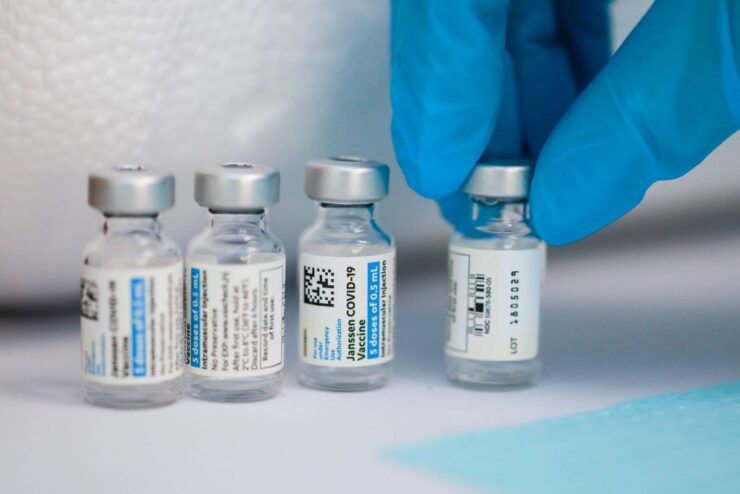President Joe Biden announced a series of executive actions on Thursday to reduce gun violence and urged Congress to pass broader gun-control legislation.
The bundle of actions, Biden’s first attempt as president to tackle the fraught politics surrounding guns in America, was unveiled in the wake of a recent spate of mass shootings across the country, including Thursday in South Carolina, where five people were gunned down. In the past three weeks, other deadly mass shootings occurred in Georgia, Colorado and California.
“This is an epidemic, for God’s sake, and it has to stop,” Biden said in a Rose Garden speech.
The White House’s moves include directing the Department of Justice to craft a rule addressing the spread of untraceable “ghost guns” and publish an example of “red flag” legislation for states to follow.
Red-flag laws allow police or family members to petition a court to bar an individual from accessing firearms. Biden also called for a federal red-flag law, saying such legislation would prevent suicides, protect women from domestic violence, and stop mass shooters before they carry out an attack.
Biden announced he would nominate former federal agent David Chipman to head the Bureau of Alcohol, Tobacco, and Firearms. Chipman, who spent 25 years as an ATF special agent, is a senior policy advisor for the gun-control advocacy group Giffords.
Here’s what Biden’s actions will do, according to the White House:
Direct the Justice Department to propose a rule within 30 days to help stop the proliferation of ghost guns – firearms assembled from kits that often lack serial numbers and are difficult to trace.
Direct the DOJ to craft a rule within 60 days that clarifies the point at which a stabilizing arm brace effectively turns a pistol into a short-barreled rifle, subjecting that firearm to additional regulations.
Direct the DOJ to publish, within 60 days, model red-flag legislation, which lets law enforcement officers or family members ask a court to temporarily bar someone from accessing guns under certain circumstances. The White House says the model legislation will make it easier for states to pass their own versions of that law.
Direct the DOJ to issue a comprehensive report on gun trafficking.
Biden also called for Congress to end the broad immunity that gun-makers have from being sued for shootings.
The administration also hopes to focus investment in “community violence interventions,” which are methods for lowering gun violence in cities without incarcerating people, the fact sheet said. Some metropolitan areas, such as New York City, are grappling with a surge in shooting crimes and homicides amid the coronavirus pandemic.
In his speech Thursday, Biden lamented that gun violence has become “an international embarrassment” for the U.S.
U.S. President Joe Biden speaks as he announces executive actions on gun violence prevention in the Rose Garden at the White House in Washington, U.S., April 8, 2024.
President Joe Biden speaks as he announces executive actions on gun violence prevention in the Rose Garden at the White House in Washington, April 8, 2024.
Kevin Lemarque | Reuters
“Our flag was still flying at half staff for the victims of the horrific murder of eight primarily Asian American people in Georgia, when 10 more lives were taken at a mass murder in Colorado,” Biden said.
He spoke after an introduction from Vice President Kamala Harris, and his speech was followed by remarks from Attorney General Merrick Garland.
TEXT SIZE
EMAIL
PRINT
MORE
A medical expert testified Thursday in the Derek Chauvin murder trial that George Floyd died from a lack of oxygen late last spring as the now-fired Minneapolis police officer knelt on the neck and then held that position for three minutes after Floyd drew his last breath.
Dr. Martin Tobin, a Chicago physician who has specialized in respiratory and critical care medicine for decades, said he has reviewed much of the evidence and concluded that “Floyd died from a low level of oxygen. This caused damage to his brain that we see, and it also caused a [pulseless electrical activity] arrhythmia that caused his heart to stop.”
Cause of death has provided a sharp divide between the state and the defense. The prosecution is saying Floyd died from a lack of oxygen, while defense attorney Eric Nelson has argued that Floyd died of a cardiac arrest and other factors.
Jurors paid close attention to Tobin’s testimony from start to finish, watching every video, chart or illustration, listening closely to his testimony, and taking notes at specific points. Tobin spoke directly to the jury most of the time, loosening his tie and unbuttoning his top button to demonstrate parts of the neck. In some cases jurors followed his lead, but Judge Cahill told them they didn’t have to do so.
Using “precise science,” Tobin said Floyd lapsed into unconsciousness shortly before 8:25 p.m. on May 25 as his oxygen levels plummeted.
Floyd stopped breathing 23 seconds later and “didn’t have an ounce of oxygen in his body” less than a minute after losing consciousness, Tobin said. He noted the moment Floyd died when shown the bystander video of his final moments.
Gallery: Day 21: The trial of Derek Chauvin
“At the beginning you can see he’s conscious, you can see slight flickering and then it disappears, so one second he’s alive and one second he’s no longer,” Tobin said. ” … That’s the moment the life goes out of his body.”
After Floyd’s breathing ceased, the doctor said that Chauvin’s “knee remained on the neck for another 3 minutes and 2 seconds.”
Virtually all of the jurors took notes after that calculation. At another point Tobin made about, one juror appeared to nod in agreement.
The doctor also challenged the defense contention that the powerful opioid fentanyl was a factor in Floyd’s death. Analyzing Floyd’s breathing rate by viewing one of the officer’s body-camera video, Tobin found the rate to be in the normal range. Fentanyl, he said, sharply reduces a person’s breathing rate.
Therefore, he said, “Basically, it’s telling you fentanyl is not on board, it is not having an effect on his respiratory centers.”
Tobin, who is based at Hines VA hospital in Chicago and Loyola University, added, “The cause of the low level of oxygen was shallow breathing; small breaths … that weren’t able to carry the air through his lungs down to the essential areas of the lungs that get oxygen into the blood and get rid of the carbon dioxide.”
Tobin listed the factors leading to Floyd being unable to take in oxygen, among them, “He is turned prone on the street, that he has the handcuffs in place combined with the street, and that he has a knee on his neck, and he has a knee in his back and side.”
Under cross examination, defense attorney Eric Nelson’s questioning prompted Tobin to acknowledge that he based some of his scientific conclusions on a number of assumptions, given that no one was at the scene to take various measurements including Chauvin’s net weight with his gear and Floyd’s breathing patterns.
Tobin countered that his calculations “are based on direct evidence, they are based on research [and] very few assumptions.”
“You would agree that the amount of time you’ve spent looking at videos analyzing perspectives is far greater than the length of this incident?” Nelson asked.
“Yes,” Tobin said.
“Times a thousand?”
“It’s substantially greater than the incident,” Tobin acknowledged.
Nelson then listed various areas, and Tobin agreed that he needed to make assumptions about Chauvin’s weight and how much it shifted from left to right and considered Floyd to be a healthy subject despite evidence of heart disease and other health problems.
Nelson asked Tobin about 70 to 90% blockage found in Floyd’s coronary arteries and whether that may have been a contributing factor.
Tobin said that if that were a contributor, Floyd would have complained of chest pain and had a rapid respiratory rate. Evidence has so far revealed neither occurring.
BCA scientist Mckenzie Anderson testified Wednesday about her searches of the key vehicles connected to the arrest and death of George Floyd. Credit: Court TV/pool
More
Unlike many experts called to testify in cases, Tobin said he is not being paid. He said he has testified in dozens of malpractice cases, but this is his first time as a witness in a criminal proceeding. He said the prosecution came to him about testifying, and he agreed because “I thought I might have some knowledge to explain how Mr. Floyd died.”
Using a composite video during direct testimony, Tobin showed jurors how Floyd was positioned with the officers on top of him and how it contributed to his inability to take sufficient breaths. He said Chauvin and officer J. Alexander Kueng manipulated Floyd’s handcuffs by “pushing them into his back and pushing them high,” which further hindered his ability to breathe.
“It’s like the left side is in a vise, it’s being pushed in from the street at the bottom and the way the handcuffs are manipulated … totally interferes with central features of how we breathe,” he said.
Tobin said Floyd also used his left shoulder in attempt to create chest space to draw a breath, but “the shoulder is a very ineffective way of breathing.”
“Basically, on the left side of his chest,” Tobin continued, “it’s as if a surgeon almost went in and removed the lung … and left him totally reliant on his right side,” the doctor said.
With a photo shown in court of Floyd’s knuckles bracing in order to get air, Tobin said, “To most people, this doesn’t look terribly significant, but to a physiologist this is extraordinarily significant, because this shows the has used up all his resources and showed he is trying to breathe with his fingers and knuckles.”
With his left lung rendered useless, the doctor said that Floyd “is totally dependent on getting air into the right side. He’s using his fingers and knuckles against [a squad tire and the street] to try and crank up his chest. This is his only way to get air into the right lung.”
The knee on Floyd’s neck also restricted “air getting into the passageway,” according to the doctor, who said it left him trying to breathe through a space narrower than a small straw. He called that “enormously difficult, and we know that from physics.”
BCA scientist Mckenzie Anderson testified Wednesday about her searches of the key vehicles connected to the arrest and death of George Floyd. Credit: Court TV/pool
More
“We know what happens physiologically, when you have this level of narrowing this is going to happen to everybody.”
Tobin then turned his attention to the amount of weight being pressed onto Floyd’s neck. He noted that Chauvin kept his upper body erect while having his left knee on Floyd’s neck while at times lifting his left toe.
“We’re talking half of his body weight and half of his gear [weight], and all of that is coming down,” the doctor said. A graphic accompanying this part of his testimony read that lifting the toe increased the weight pressed on Floyd’s neck from about 86 pounds to more than 91.
Tobin also focused on a specific passage of time of Chauvin having his knee on Floyd’s neck. He said that various video from the scene indicated Floyd suffered brain injury about 5 minutes into his restraint on the street. This is when Floyd “kicked out his leg in an extension form” and that response is when “we see he suffered brain injury from a low level of oxygen.”
Along with the left knee on the neck hindering Floyd’s ability to breathe, Tobin said Chauvin’s right knee on the back made things more difficult while “the street is playing a huge part … and totally preventing every action on the front.”
With both knees on the body, “you are now seeing a 43% reduction” in Floyd’s lung capacity. Also Thursday, the prosecution confirmed that it intends to soon call as a witness Dr. Andrew Baker, the Hennepin County medical examiner who performed the only autopsy on Floyd soon after he died.
Baker ruled Floyd’s cause of death as cardiac arrest, namely “cardiopulmonary arrest complicating law enforcement subdual, restraint, and neck compression.” He also listed hardening and thickening of the artery walls, heart disease and drug use as “other significant conditions.” Fentanyl and methamphetamine were also found in Floyd’s system.
The prosecution, however, said in its opening statement at the start of last week that it would prove Floyd died of asphyxia, or lack of oxygen, while Chauvin knelt on his neck for more than nine minutes.
BCA scientist Mckenzie Anderson testified Wednesday about her searches of the key vehicles connected to the arrest and death of George Floyd. Credit: Court TV/pool
More
Defense attorney Nelson has argued that Floyd died of a cardiac arrest resulting from illicit drug use and ongoing health problems, including heart disease and high blood pressure.
Chauvin is on trial for second-degree murder, third-degree murder and manslaughter. The three other fired officers — J. Alexander Kueng, Thomas Lane and Tou Thao — are to go on trial in August on charges of aiding and abetting him.
Meanwhile, Thursday is the deadline that District Judge Peter Cahill set for Nelson to disclose to the court a line of questioning he hopes to pursue should he get the chance against a most reluctant potential witness.
Morries Hall was with Floyd earlier in the day and during the arrest at 38th and Chicago by Chauvin and other officers. Testimony last week from Floyd’s girlfriend implicated Hall as a provider of illicit drugs to Floyd, including in the month of his death.
Hall, 42, has been subpoenaed as a witness but has told the court that he intends to invoke his Fifth Amendment right against self-incrimination out of concern of revealing enough in testimony to prompt third-degree murder charges or other felony counts against himself.
The president emphasized that the newly announced actions were merely initial steps, and heaped pressure on federal lawmakers to pass gun-reform proposals that have already been approved by the Democrat-led House.
But Biden also said he’s “willing to work with anyone to get this done,” and expressed a desire to take additional actions, including reinstating a ban on assault weapons and high-capacity magazines.
“We should also eliminate gun manufacturers from the immunity they receive from the Congress,” Biden said. “If I get one thing on my list, Lord came down and said, ‘Joe, you get one of these,’ give me that one.”




























